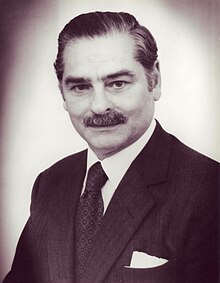Carol Lambrino
| Prince Carol Mircea | |||||
|---|---|---|---|---|---|
 |
|||||
| Born |
8 August 1920 Bucharest, Kingdom of Romania |
||||
| Died | 27 January 2006 (aged 85) London, United Kingdom |
||||
| Burial | Cozia Monastery | ||||
| Spouse | Helene Henriette Nagavitzine Thelma Williams Antonia Colville |
||||
| Issue |
Paul-Philippe Hohenzollern Alexander Hohenzollern |
||||
|
|||||
| Father | Carol II of Romania | ||||
| Mother | Zizi Lambrino | ||||
| Religion | Romanian Orthodox Church | ||||
| Full name | |
|---|---|
| Mircea Grigore Carol Hohenzollern |
Prince Mircea Grigore Carol Hohenzollern (8 August 1920 – 27 January 2006), also known as Prince Mircea Grigore Carol al României (anglicised as: of Romania) according to his amended Romanian birth certificate or as Carol Lambrino according to his original Romanian birth certificate, was the eldest son of King Carol II of Romania.
Prince Carol was born in Bucharest as son of Crown Prince Carol of Romania and his first wife, Zizi Lambrino. At the time of his birth he was registered with the name Mircea Grigore Carol Lambrino. His grandfather King Ferdinand forced the annulment of his parents' marriage in January 1919 in the Supreme Court of Romania and Carol was born outside the 300-day period allowed to permit legitimacy, on 8 August 1920. The legality of the annulment has been questioned.
After his birth, Carol and his mother were forced to leave Romania and settled in Paris. During his younger years and his reign, including during his personal dictatorship (1938–1940) when he held absolute power in Romania, King Carol II recognized his first-born Carol Mircea as a prince on several occasions. One of these situations was a letter published on the front page by the Romanian daily newspaper Epoca (17 January 1920). Signed by Crown Prince Carol, the document is a statement in which the future king recognizes he is the father of Princess Ioana's baby. More, the Princely House of Hohenzollern-Sigmaringen has always recognised them as princes of Hohenzollern (or the German style family name Prinz von Hohenzollern) as it becomes clear in correspondence between the late Prince Friedrich of Hohenzollern-Sigmaringen and the deposed King Carol II.
After the death of his father, King Carol II, in Portugal, 4 April 1953, Carol claimed the right to inherit some of his father's estate in accordance with Portuguese law. In order to do so, it was necessary to prove that he was his father's legitimate son born of a legitimate marriage.
On April 2, 1955, a Portuguese court ruled that Carol was the legitimate first-born son of King Carol II and allowed him to claim the surname Hohenzollern in place of Lambrino. On 6 March 1957, the Portuguese ruling was recognised in France by an Exequatur of the Tribunal of the Grande Instance of Paris. This allowed Carol rights of inheritance to his father's French properties. Carol's younger half-brother Michael appealed this ruling which was upheld by the Court of Cassation, 8 January 1963.
...
Wikipedia
